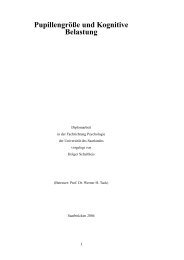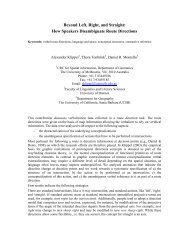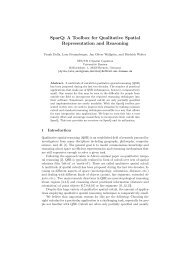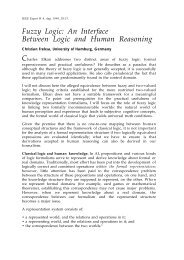Schematic Maps for Robot Navigation - the Cognitive Systems Group
Schematic Maps for Robot Navigation - the Cognitive Systems Group
Schematic Maps for Robot Navigation - the Cognitive Systems Group
Create successful ePaper yourself
Turn your PDF publications into a flip-book with our unique Google optimized e-Paper software.
In practice, however, this approach does not work. What are <strong>the</strong> problems? First, it<br />
is very hard to provide <strong>the</strong> robot with detailed knowledge about its spatial<br />
environment in such a way that this knowledge actually agrees with <strong>the</strong> encountered<br />
situation in <strong>the</strong> environment at a given time in all relevant aspects. Even if it agrees, it<br />
is impossible to get <strong>the</strong> robot to carry out actions that correctly reflect <strong>the</strong> computed<br />
result. Second, <strong>the</strong> real world is inherently dynamic: knowledge about <strong>the</strong> state of <strong>the</strong><br />
world at a given time does not guarantee <strong>the</strong> persistence of that state at a later time.<br />
Why is autonomous robotics so difficult? The general problem a robot must cope<br />
with when acting in <strong>the</strong> real world is much harder than <strong>the</strong> problem a computer 2 must<br />
deal with when solving problems. The reason is that autonomous robots live in two<br />
worlds simultaneously while computers only must deal with a single world.<br />
Autonomous robots live in <strong>the</strong> physical world of objects and space and in <strong>the</strong> abstract<br />
world of representation and computation. Worst of all: <strong>the</strong>se two worlds are<br />
incommensurable, i.e., <strong>the</strong>re is no <strong>the</strong>ory that can treat both worlds in <strong>the</strong> same way<br />
(Palmer, 1978; Dirlich et al., 1983).<br />
Computers act entirely in a <strong>for</strong>malized computational (mental) world: <strong>the</strong>ir<br />
problems are given in <strong>for</strong>malized <strong>for</strong>m, <strong>the</strong>y compute on <strong>the</strong> basis of <strong>for</strong>malized<br />
procedures, and <strong>the</strong> results come out as <strong>for</strong>mal statements. The physical existence and<br />
appearance of computers are not essential <strong>for</strong> <strong>the</strong> solution of <strong>the</strong> <strong>for</strong>mal problem.<br />
Autonomous robots, on <strong>the</strong> o<strong>the</strong>r hand, are not only superficially submerged in <strong>the</strong><br />
physical world; <strong>the</strong>y are essential physical parts of <strong>the</strong>ir own physical environment.<br />
When a robot moves, <strong>the</strong> physical world changes. In addition to <strong>the</strong>ir physical<br />
existence, autonomous robots have an important mental facet: autonomous robots are<br />
controlled by computers that compute <strong>the</strong> decisions about <strong>the</strong> robots’ actions in <strong>the</strong>ir<br />
physical environment.<br />
We can take at least two views regarding <strong>the</strong> relationship between <strong>the</strong> physical<br />
robot and its controlling computer: (1) We can consider <strong>the</strong> computer as just a piece<br />
of physical circuitry that connects sensor inputs to motor outputs in a more or less<br />
complex way. In this view, we do not need to consider representations and mental<br />
processes; all issues can be addressed in <strong>the</strong> physical domain. (2) We acknowledge<br />
that <strong>for</strong>mal <strong>the</strong>ories about physical space are required <strong>for</strong> intelligently acting in a<br />
physical environment. Then we have two options: (a) we believe that <strong>the</strong>se <strong>the</strong>ories<br />
can be made sufficiently precise to describe all that is needed to per<strong>for</strong>m <strong>the</strong> actions<br />
on <strong>the</strong> level of <strong>the</strong> representations; this option corresponds to <strong>the</strong> classical AI<br />
approach. Or (b) we recognize that it is unfeasible to employ a global <strong>the</strong>ory that<br />
accounts <strong>for</strong> all aspects <strong>the</strong> robot may be confronted with in physical space. Then we<br />
can <strong>for</strong>malize a <strong>the</strong>ory that deals with some aspects of <strong>the</strong> physical world and leaves<br />
o<strong>the</strong>r aspects to be dealt with separately – <strong>for</strong> example in <strong>the</strong> manner suggested by <strong>the</strong><br />
first view.<br />
The first view was brought <strong>for</strong>ward most prominently by Brooks (1985). It works<br />
well on <strong>the</strong> level of describing reactive behavior and <strong>for</strong> modeling adaptation<br />
behavior of insects and robots in <strong>the</strong>ir environments (Braitenberg, 1984). However, it<br />
has not been possible to describe purposeful proactive behavior in this paradigm, so<br />
2 We use <strong>the</strong> term ‘computer’ to designate <strong>the</strong> abstract reasoning engine and <strong>the</strong> term ‘robot’ to<br />
designate a physical device with sensors and effectors that interact with <strong>the</strong> environment and<br />
with a computer that interprets <strong>the</strong> sensor data and controls <strong>the</strong> actions.







